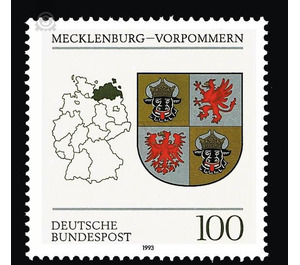Coat of arms of the Land of the Federal Republic of Germany (2) - Germany / Federal Republic of Germany 1993 - 100 Pfennig
Theme: Art & Culture
| Country | Germany / Federal Republic of Germany |
| Issue Date | 1993 |
| Face Value | 100.00 |
| Color | multi-colored white |
| Perforation | K 13 3/4 |
| Printing Type | Multicolor offset printing |
| Stamp Type | Postage stamp |
| Item Type | Stamp |
| Chronological Issue Number | 1534 |
| Chronological Chapter | GER-BRD |
| SID | 161723 |
| In 36 Wishlists | |
The Duchy of Mecklenburg emerged from the Slavic tribal area of the Obodrites in the 12th century. His coat of arms was a crowned, black bull's head on a gold background. The first evidence for this coat of arms date back to around 1200. Despite repeated country divisions, the individual Mecklenburg duchies remained united in a hereditary alliance. Important for the newer history was the Erbvergleich of 1701. Since that time there were the two independent states Mecklenburg-Schwerin and Mecklenburg-Strelitz. They carried the same coat of arms. It was not until the November Revolution of 1918 that the Mecklenburg duchies withdrew from their estates and developed into modern states. In 1934, they were merged into the state of Mecklenburg. The Vorpommern area grew from the Principality of Rügen with its mainland parts, which had developed in the 12th century from the Slavic tribal association of the Ranen, and the area of Wilzen, later called Lutizen, which had been conquered by the Pomeranian princes in 1128. After the extinction of Rügenfürsten 1325 the Principality of Rügen fell to the Dukes of Pomerania. The heraldic animal of the Pomeranian dukes was the griffin. First testimonies date back to around 1200. According to their heraldic animal, the Pomeranian dukes referred to themselves as the griffin family. During the Thirty Years' War, the Griffins family went out. Pomerania fell to the crown of Sweden due to military successes due to old hereditary contracts to Brandenburg / Prussia and Vorpommern. In the ensuing clashes between Sweden and Brandenburg / Prussia, Sweden had to cede parts of Swedish Pomerania to Brandenburg / Prussia. As a result of the liberation wars 1815 Swedish Pomerania could be reunited with the parts of Pomerania fallen to Brandenburg. All of Pomerania developed since then as a self-governing province within the Prussian state association and shared the fortunes of Prussia. After the collapse of National Socialist Germany, new state administrations were established. The territory of Western Pomerania was affiliated to the state of Mecklenburg at the decision of the Soviet occupying power. After the dissolution of the state of Prussia, the Soviet military administration forbade the state government to use the name "Vorpommern" in addition to the name "Mecklenburg". After the reunification of the two German states, Mecklenburg-Vorpommern was founded as a new federal state. The coat of arms adopted for the new federal state on June 14, 1991 contains references to the historical development. The coat of arms is divided into four parts and shows twice, diagonally opposite each other, the crowned Mecklenburg bull's head with its red tongue pulled out and its neck-neck cut off on a gold background. The doubling of the bull's head is reminiscent of the two long independent states of Mecklenburg-Schwerin and Mecklenburg-Strelitz. In the upper right field of the bull's head is the red Pomeranian griffin with golden reinforcement and herausgeschlagener red tongue on a silver background for the part of the country assigned to Western Pomerania. The lower left field opposite him shows the red Brandenburg eagle with golden armor, red tongue and golden sticking stems on the wings also on a silver background. The eagle refers to the fateful connection of Pomerania with Brandenburg. (Text: Dr. Norbert Buske, Levenhagen)


